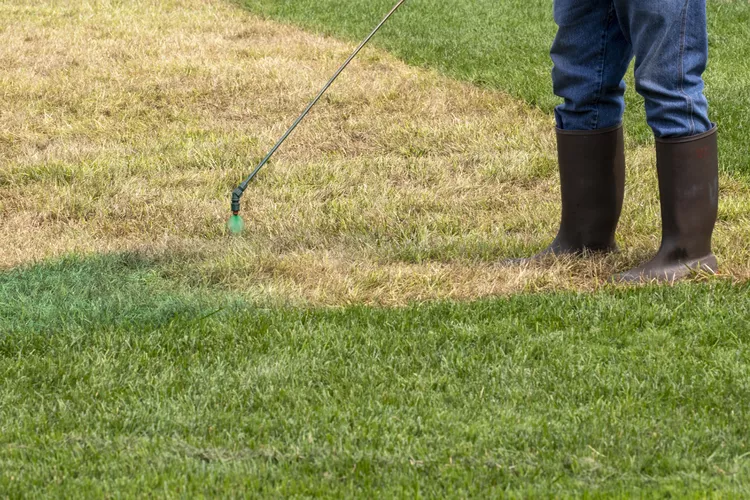Until recently, grass paints—called turf colorants by those in the green industry—were used exclusively on golf courses and professional sports fields. These instant green-up products were not formulated and distributed in ways that were usable on the average backyard patch of lawn. But new technologies, combined with a desire for a green lawn without some of the environmental impact necessary to make it happen, brought grass paint to the shelves of home improvement stores. Is it a good choice for your lawn? Here’s everything you need to know about grass paint and how to use it.
What is grass paint?
First, it’s critical to note what grass paint is NOT. It is not spray paint that you might use on a piece of furniture. Grass paint is a combination of water, pigments, and binders, along with proprietary additives, for use on turf grass. It will stain hard surfaces, such as concrete, fences, and landscape blocks, but it has limited adverse impact on the environment.
Count on it to color grass for two to eight weeks or so depending on the product and weather conditions. The shades of green created by grass paint vary widely. One product might produce a realistic green hue on your turf while another product might create an unnatural looking blue-green lawn. Test a small patch of turf before painting your entire lawn.
Why use grass paint?
Grass paint first became popular as an alternative to winter overseeding in the southern US. Bermuda grass, a warm season grass popular in the South, is often overseeded with ryegrass to create a lush green winter lawn. The water, fertilizer, and maintenance required to grow a ryegrass lawn in winter is significant. Turf grass specialists found that grass paint applied to early dormant Bermuda grass can achieve a similar green appearance without the high fertilizer and water inputs that ryegrass requires. Grass paint is also useful in drought situations.
Instead of watering extensively to maintain a green lawn, paint it. Grass paint doesn’t harm a lawn; the grass will resume growing when the drought conditions subside.
Types of Grass Paint
Increasingly available at garden centers and home improvement stores, grass paint is most commonly available as a concentrate. The product is mixed with water and then applied using a garden pump sprayer. Concentrated grass paint products are useful for painting an entire lawn. Some grass paint brands are available ready-to-use in spray bottles. These pre-mixed spray bottles are perfect painting patches of brown turf, such as those caused by pets, but not an entire lawn.
Tips for Painting Your Lawn
1. Invest in a quality pump sprayer.
Painting an entire lawn, as opposed to painting patches of grass here and there, calls for a 2-gallon pump sprayer. Thoroughly mix the grass paint concentrate with water according to package directions in the sprayer vessel and then attach the pump and pump vigorously. When applying grass paint, pump the sprayer frequently so it emits a steady stream of grass paint.
2. Apply grass paint before the grass is crispy and brown.
Turf scientists have found that the most natural green color is achieved when grass paint is applied to grass that is still partially green or semi-dormant. Dormancy is a natural rest period for turf grass brought on by winter growing conditions or drought. The best time to paint a lawn is when it is partially green, before it enters full dormancy.
3. Water deeply first.
Dry lawn grass blades will absorb the liquid in grass paint, skewing the color and minimizing the effect of the paint. Water grass thoroughly the day before painting. Be sure the grass blades are completely dry before painting a lawn. Mid-day, after morning dew dries and before evening dew sets in, is the best time to apply paint.
4. Apply on a warm day.
Grass paint adheres best to grass blades when the air temperature is above 45°F. Do not apply grass paint if frost is present or predicted within a few hours.
5. Spray carefully.
Grass paint will color everything it touches. Sidewalks, fences, and landscape stone will take on a green hue if hit by grass paint. Spray carefully and protect vulnerable areas by covering them with newspaper or landscape plastic.
6. Allow for dry time.
Grass paint will dry in 30 to 60 minutes in full sun. Paint takes significantly longer to dry when it is cloudy. After grass paint is dry, color transfer is reduced, but it will still stain clothing. Painted lawns are not ideal for a backyard football game and other activities that include grass contact.




















